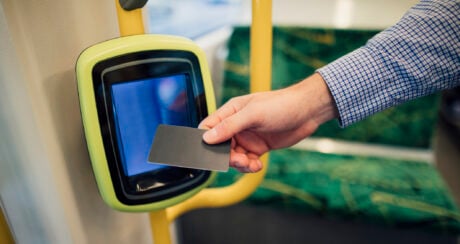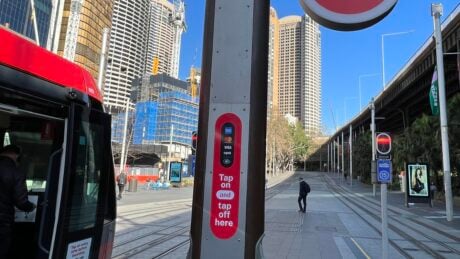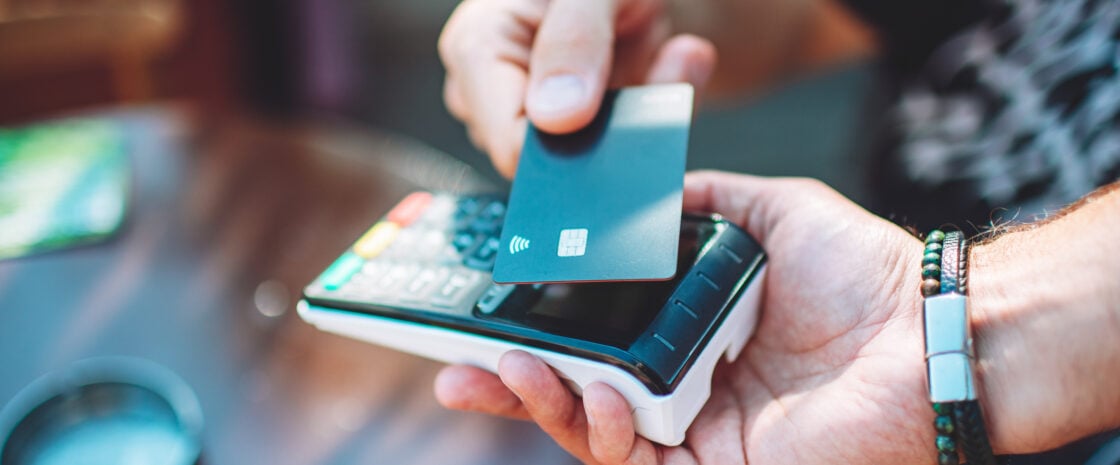More Australians are using contactless payments now than ever before. In 2022, 95% of all in-person transactions were contactless[1]. Tapping a card or waving a mobile phone is faster and more convenient and prevents contact with payment machines, so inserting a card or even carrying cash is unnecessary.
What is a contactless payment?
A contactless payment is a transaction you can make without swiping or inserting a card. It is a safe and easy way to make in-person purchases with a card or mobile device.
‘Contactless payments’ are also known by other common terms and phrases. These include:
- Tap and pay
- Tap and go
- Tap to pay
- Tap on
- Tapping a card
- Mobile payments
- Apple payments
- Mobile or digital wallet payments
- Mastercard’s PayPass
- Visa’s PayWave.
How do contactless payments work?
Contactless payments rely on wireless technology to quickly exchange secure information with a compatible payment terminal. Mobile devices use near-field communications (NFC) technology, and contactless cards use radio-frequency identification (RFID).
To make a contactless payment, simply tap your card or wave your mobile phone, double-click your Apple Watch or bring your Garmin watch close to a contactless reader. You don’t need to sign or enter your PIN (for transactions under $100).
Most credit cards in Australia are contactless-enabled.

Want to know if your card can make a contactless payment?
Just look for this four-curved line symbol on your card. You’ll see the same symbol at the EFTPOS machine or payment terminal when a store accepts contactless payments.
» MORE: How are credit card payments processed?
Types of contactless payments
There are two main types of contactless payments.
Contactless credit card payments
Mastercard and Visa are the big credit card companies in Australia. You can tap and go if you have a card with a universal contactless symbol (the four curved lines). Visa PayWave and Mastercard PayPass work the same way and allow you to tap your credit card at the point of sale.
Contactless mobile payments
You can make contactless payments via your smartphone using Apple Pay, Google Pay (for Android phones) and Samsung Pay (for Samsung phones). You can also use your device in-store when you see the contactless symbol. If your digital wallet contains a virtual credit card, this is how you’d use it in person.
Additionally, you can set up contactless payments if you wear an Apple Watch, Fitbit, Garmin, or other suitable wearable devices.
🤓 Nerdy Tip
Contactless payments are new but growing. Two-thirds of young Australians now use mobile payments. As a result, the Australian Government plans to regulate digital payment services used in digital wallets in the same way as credit cards.
» MORE: What is a digital wallet?
Contactless credit card options in Australia
Many Australian banks and issuers have contactless payment options. This table overviews what’s on offer, but compatibility and eligibility may vary. Check with the bank or credit card provider to be sure about a specific card.
| Bank | Ways to pay | Digital wallet compatibility |
|---|---|---|
| ANZ | Contactless card Smartphone Wearable device | Apple Pay Google Pay Fitbit Pay |
| Bank of Melbourne | Contactless card Smartphone Wearable device | Apple Pay Google Pay Samsung Pay |
| Bank of Queensland | Contactless card Smartphone Wearable device | Apple Pay Google Pay Samsung Pay |
| Bankwest | Contactless card Smartphone Wearable device | Apple Pay Google Pay |
| Bendigo Bank | Contactless card Smartphone Wearable device | Apple Pay Google Pay Samsung Pay Fitbit Pay Garmin Pay |
| Citibank | Contactless card Smartphone Wearable device | Apple Pay Google Pay Samsung Pay |
| Commonwealth Bank | Contactless card Smartphone Wearable device | Apple Pay Google Pay Samsung Pay |
| HSBC | Contactless card Smartphone Wearable device | Apple Pay Google Pay |
| ING | Contactless card Smartphone Wearable device | Apple Pay Google Pay |
| Macquarie Bank | Contactless card Smartphone Wearable device | Apple Pay Google Pay |
| NAB | Contactless card Smartphone Wearable device | Apple Pay Google Pay Samsung Pay Fitbit Pay Garmin Pay |
| St. George | Contactless card Smartphone Wearable device | Apple Pay Google Pay Samsung Pay |
| Suncorp | Contactless card Smartphone (on Suncorp Clear Options credit cards) | Apple Pay Google Pay Samsung Pay |
| Westpac | Contactless card Virtual card Smartphone Wearable device | Apple Pay Google Pay Samsung Pay Fitbit Pay Garmin Pay |
How to pay with a contactless credit cards
Making a contactless credit card payment is easy:
- Check for the contactless symbol on your card and the payment terminal.
- Hold your card about two centimetres from the machine, closest to the symbol.
- If you have more than one contactless credit card in your wallet or purse, take out the card you want to use rather than tapping your wallet against the reader.
- If the total transaction is under $100, it’ll be approved. If it’s over $100, you’ll need to enter your PIN.
- Purchases show up on your statement as they usually would.
» MORE: Pros and cons of using credit cards
Are contactless payments safe?
While there are warnings about using contactless mobile payments, the consensus is that they are safe. ApplePay, for example, uses Face ID and Touch ID to authorise payments, and card numbers aren’t stored on devices or Apple servers or shared with merchants.
But what about if you lose your credit card. Or, it get stolen. While this does happen, it’s unlikely — especially if you make smart, safe financial decisions. For example, only carry one card when going out, check your account daily, and keep an eye on text messages or emails from your bank for suspicious transactions.
Credit cards also come with robust protections against fraud. For example, Westpac offers purchase protection insurance. All Mastercard cardholders have Zero Liability protection.
» MORE: How to spot and avoid credit card scams
Should you use contactless payments?
As with all financial offerings, there are benefits and disadvantages. Use your judgment about what’s best for you. Contactless payments, while super convenient, can add up — which can lead to credit card debt.
Advantages
- Cash-free convenience. It’s faster, easier, and more convenient for transactions under $100. You don’t have to carry around cash or worry about change.
- Touch-free payments. You don’t have to touch a payment terminal, EFTPOS machine or screen.
- You can make mistakes. If you accidentally tap twice at checkout, you’ll only get billed once.
- Used for (almost) everything. There are no limitations on the types of transactions considered acceptable. Where you see the contactless payment symbol, you can tap and go.
Disadvantages
- Not used everywhere. Not every payment terminal is contactless — you might still need to swipe or insert your card.
- You must still enter your PIN if your transaction is above $100.
- Safe doesn’t mean risk-free. Contactless payments are considered safe, but it’s still important to be extra cautious with your credit and debit cards. Make sure you know where they are, but only take one out with you and check your accounts regularly.
- Tapping costs retailers. PayWave and PayPass incur a ‘merchant service fee’ — similar to a surcharge — which is higher than the standard EFTPOS system fee. For this reason, retailers might move away from contactless.
- Changes are coming. Regulation is underway so there will likely be more limitations in the future.
Frequently asked questions about contactless payments
Yes. You can pay with your phone by using contactless cards, ApplePay, GooglePay digital wallets, and smart devices. Most credit cards in Australia offer a contactless option.
It will either be on the front of the card, to the right of the 16 digits or on the back, to the right of the signature strip. The PayWave and PayPass symbols are the same — it’s the four curved lines that look like a signal.
Article Sources
-
Reserve Bank of Australia, “Consumer Payment Behaviour in Australia,” accessed February 16, 2024.
DIVE EVEN DEEPER

Can You Tap On With A Credit Card On A Bus?
Tap and pay is convenient for in-person transactions — but can you do it on public transport?

Can You Tap On With A Credit Card On A Train?
You can tap on with a credit or debit card on a train in Sydney, Newcastle, Brisbane, Gold Coast and Adelaide — and soon in Melbourne and Canberra.

Opal Card Vs. Credit Card
What’s the more convenient and cost-effective way to navigate Sydney and its surrounds — Opal or credit card?

Can I Use A Credit Card Instead of Myki on Melbourne Public Transport?
You can’t use a credit card instead of Myki yet, but you’ll eventually be able to use your credit card on Melbourne public transport.

